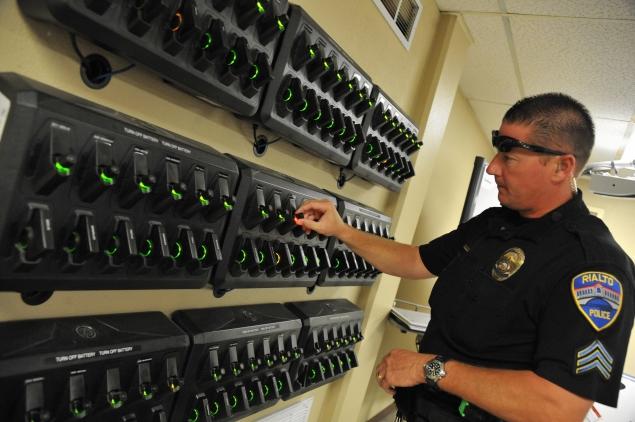On-Officer Video: A Ground Up Approach
 The topic of “on-officer video” (also referred to as body-worn cameras) has sparked controversy in the law enforcement community, pitting management against line personnel, in a battle over a technology that should be viewed as a valuable tool for each side. On-officer video offers a variety of benefits to both the individual officer and the department. However, many police associations and union groups oppose the implementation of this equipment. Why is the concept of officers videotaping their contacts with the public producing such an adverse reaction?
The topic of “on-officer video” (also referred to as body-worn cameras) has sparked controversy in the law enforcement community, pitting management against line personnel, in a battle over a technology that should be viewed as a valuable tool for each side. On-officer video offers a variety of benefits to both the individual officer and the department. However, many police associations and union groups oppose the implementation of this equipment. Why is the concept of officers videotaping their contacts with the public producing such an adverse reaction?
To answer that question, it may be useful to start by considering the manner in which the typical agency evaluates new equipment. Most decisions to purchase equipment are made at the top of the organization, without input from the end user. Command staff identifies a potential tool or technology and then directs staff to evaluate it. If approved, the item is purchased, policy is developed, training provided, and ultimately it is deployed.
This approach generally works for routine purchases, such as flashlights and software. When considering radically different systems such as on-officer video, this approach is fraught with unintended consequences that may undermine a successful implementation. Requiring police officers to wear video cameras represents a fundamental change in almost every aspect of their job, including evidence collection, use of force reviews, officer involved shooting investigations, personnel complaints, critical incident debriefs, and training. Additionally, many suspicious field personnel are concerned that their videos may be used misused by unscrupulous supervisors who seek to target them.
The FIT Approach
As illustrated, the typical top-down approach to equipment purchases is ineffective in situations where emotions and mistrust are high, such as placing video cameras on officers. Using a bottom-up method, such as Focus-Involvement-Testing (FIT) is a superior method, since it involves officers in the early stages of the evaluation process. For example, as it relates to on-officer video, the FIT method would seek volunteers to wear the cameras and provide feedback. As these officers test the new equipment, they will recognize not only how the new equipment will make their jobs easier, but how it may save their careers.
 The Los Angeles Police Department currently has in-car video systems deployed in several of their patrol divisions. A recent article in the Los Angeles Times illustrates what can go wrong when you don’t have buy-in from your line personnel. According to the Times, “An inspection by the Los Angeles Police Department investigators found about half of the estimated 80 cars….were missing antennas, which help capture what officers say in the field.” The Times suggested that officers were intentionally removing the antennas so that their voices would not be captured on the in-car video system. This example illustrates that when trust issues exist and emotions are high officers may resort to sabotage in a misguided attempt at self-preservation. When this occurs, neither the officer nor the agency derives any benefit from the technology. The FIT approach solicits the officer’s opinion about the equipment and how to introduce it to the organization. If managed correctly, this approach will diminish many of the negative assumptions about the on-officer video and instead, provide positive stories about its usefulness.
The Los Angeles Police Department currently has in-car video systems deployed in several of their patrol divisions. A recent article in the Los Angeles Times illustrates what can go wrong when you don’t have buy-in from your line personnel. According to the Times, “An inspection by the Los Angeles Police Department investigators found about half of the estimated 80 cars….were missing antennas, which help capture what officers say in the field.” The Times suggested that officers were intentionally removing the antennas so that their voices would not be captured on the in-car video system. This example illustrates that when trust issues exist and emotions are high officers may resort to sabotage in a misguided attempt at self-preservation. When this occurs, neither the officer nor the agency derives any benefit from the technology. The FIT approach solicits the officer’s opinion about the equipment and how to introduce it to the organization. If managed correctly, this approach will diminish many of the negative assumptions about the on-officer video and instead, provide positive stories about its usefulness.
Focus
 It is evident that on-officer video will transform law enforcement. As discussed earlier, the on-officer video system can accomplish many important objectives; some of which are more important than others. Agencies that are considering this technology should emphasize how this system can benefit police officers. One of the most important advantages is protection from false allegations of misconduct. There are numerous examples of excessive force allegations that have been quickly unfounded after viewing the on-officer video footage. This not only saves officers from costly and frustrating litigation, but more important, from possible criminal prosecution. Law enforcement has seen a disturbing trend in which the number of officers being sent to prison is increasing. It is critical that officers are educated about the various ways that an on-officer video system can protect them and their families.
It is evident that on-officer video will transform law enforcement. As discussed earlier, the on-officer video system can accomplish many important objectives; some of which are more important than others. Agencies that are considering this technology should emphasize how this system can benefit police officers. One of the most important advantages is protection from false allegations of misconduct. There are numerous examples of excessive force allegations that have been quickly unfounded after viewing the on-officer video footage. This not only saves officers from costly and frustrating litigation, but more important, from possible criminal prosecution. Law enforcement has seen a disturbing trend in which the number of officers being sent to prison is increasing. It is critical that officers are educated about the various ways that an on-officer video system can protect them and their families.
As an example, a mid-sized law enforcement agency was considering the use of on-officer video. When the police officer’s association was polled, there was unanimous objection to the technology based on the fear that officers were going to be micromanaged by supervisors and management in the station. Because the department had not educated the organization about the various benefits of the system, rumors and speculation created suspicion about management’s motive. Once officers understood how video could protect them from false claims, on-officer video began to gain support.
Involvement
Policies related to new procedures are often written by a manager and then imposed on the organization without discussion or collaboration. When applied to on-officer video, policy should be developed with input from all of the stakeholders, including the police officer’s association. Involving all of the interested parties in these discussions is critical to generating understanding and trust. Utilizing this approach, agencies and their personnel can find common ground in order to create a win-win result.
During the policy discussions with the agency mentioned above, concerns were identified about how supervisors would access and audit video files. Management wanted wide latitude to be able to audit video files to ensure expectations related to customer service were being met. The employee association was concerned that unrestrained auditing would allow supervisors to target a specific employee and conduct audits until they discovered policy violations. Management compromised on the issue and worked with the association to construct a limited audit policy that met the needs of both sides. Management and the association provided education to the association membership (end users) about the win-win benefits and the collaborative policy development. The membership, feeling their voices were heard and concerns were addressed, were now able to clearly see the benefits of on-officer video.
Testing
After having a policy in place, the agency should test their proposed solution to identify whether the equipment works as designed and whether the established policies are effective. Selecting the right personnel to test the system is a critical decision. Consideration should be given to finding a balance between champions and critics. When employees begin to hear success stories from their peers, it provides a powerful testimony that changes their views. At the end of the testing period, the stakeholders should meet again to discuss needed changes to policies or equipment and work toward a wider deployment.
Conclusion
The mid-sized agency referenced above utilized this method and realized a dramatic shift in opinion. The association conducted a follow-up poll with their membership prior to adoption and found that the tide had swung from 100 percent opposition to 85 percent support for on-officer video. The officers and the agency are now experiencing the benefits of this revolutionary system. After three months, the on-officer video system has already prevented in excess of 20 unfounded complaints from ever being initiated. It also captured video of an officer involved shooting, which showed that the suspect was armed with both a gun and a knife.
On-officer video is a technology that will have a profound effect on law enforcement. Police officers will no longer be the victims of partial video clips that do not show the full context of an encounter, but will be able to prove that their actions were appropriate and reasonable. When properly implemented, this technology should be a win-win for employees, management, and the communities they serve. Successful implementation is best achieved when the end users collaborate with management to develop protocols that work best for their departments.
Sergeant Aaron Kelliher
Chino (California) Police Department
Keeping Your Schools Safe | On-Officer Video | National Police Week | INTERPOL Washington and Nlets | Medal of Valor Nominations
